“Always do what’s best for the tree,” says an avocado farmer that I respect. What he means is, when deciding whether to do something to the tree — water or stake or whitewash or shade or prune — base your decision on the answer to just one question: Is it best for the health of the tree?
In other words, it’s about the tree, it’s not about you. Sometimes you should do something that is bad for you in the short term but good for the tree in the long term. Ultimately, it will be good for all.
One example of this is the occasional need to sacrifice immature avocados.
Here are three times when, in my experience, this fruit removal is wise:
Stunt or topple young trees
Certain varieties, or certain trees of any variety in a good pollination situation, will set fruit when still young and small. In fact, they can set more fruit than they can comfortably carry. A few varieties that commonly do this are GEM, Gwen, Reed, and Pinkerton.
If you don’t intervene, such a tree will at best have stunted growth. At worst, the weight of the avocados can topple the little tree.
In such a situation, I do two things: make sure the small tree is staked properly if it needs to be staked, and remove some fruit. I don’t allow my trees to hold more than one or two avocados until they are as tall as me. Even when they are up to head height, I only let them hold around a dozen.
(For more on staking, see this post. And see this post about forming the shape of young avocado trees.)
(Also see my post, “Should you remove avocados from a small tree?”)
Sunburn fruit and branches
When there are many avocados on a single branch, the branch bends down and leaves no longer shade the fruit or branch. Avocado fruit and bark are easily sunburned, especially in inland locations where the sun is stronger than near the ocean.
Avocados that are significantly sunburned will have a rotten portion inside once they’re harvested and ripened.

Branches that are significantly sunburned will have weakened growth and might even die back.

Break branches
But the most severe scenario is when there is so much fruit on a particular branch that it snaps off. Ouch!
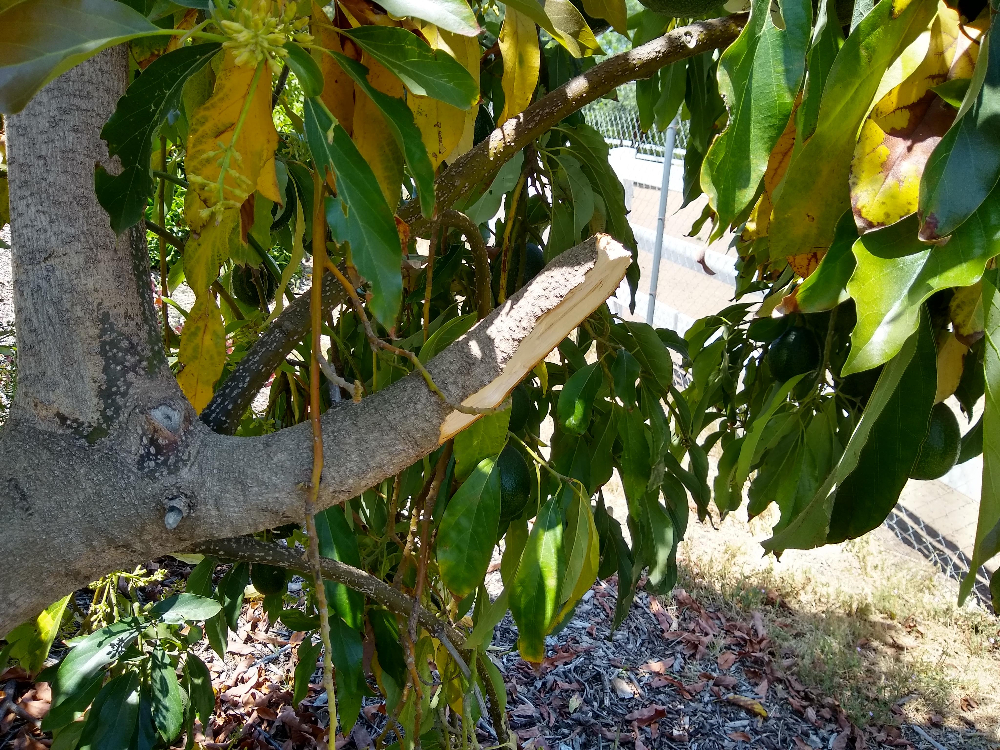
I’ve seen this happen to trees of a few varieties, but I’ve only had it happen to the Reed variety in my yard. I think this is because the Reed fruit gets bigger than most other varieties.
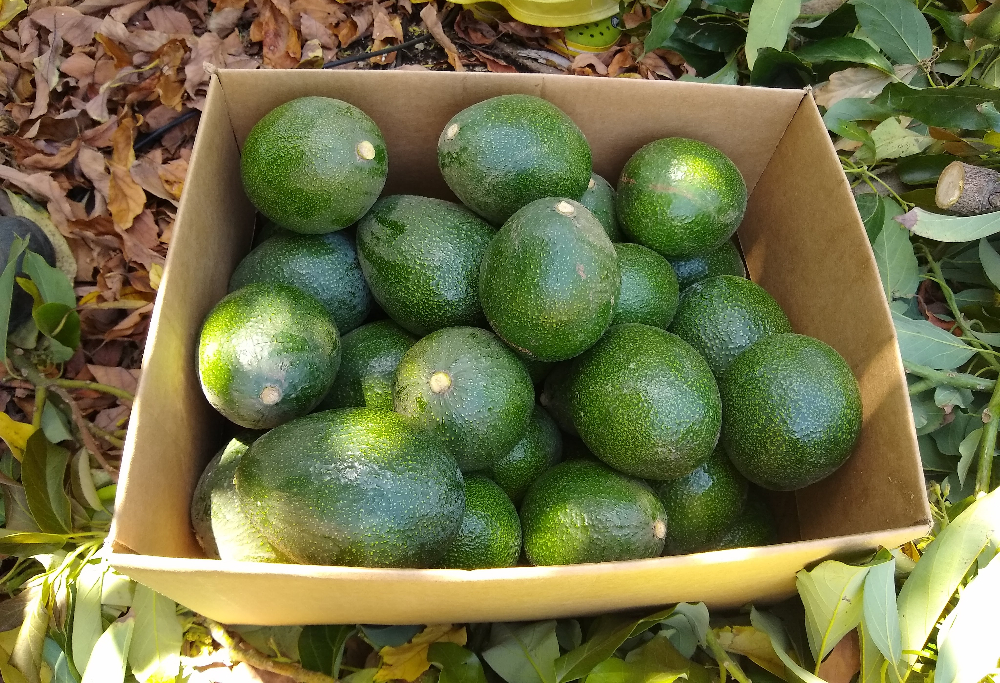
How to prevent branch breaking? Some growers support (prop) branches with 2×4 pieces of wood.
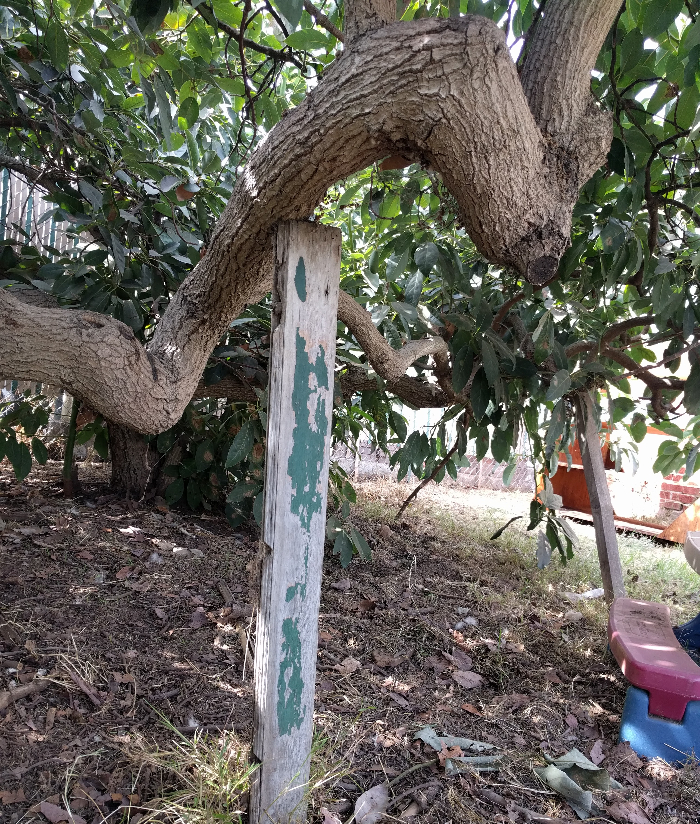
This can work, but it is not fail-safe. High winds during a winter storm or a Santa Ana (east wind) event can jostle the branch free from the prop.
For this reason, I prefer thinning fruit over propping branches. But which avocados to remove? And how much to remove? These are not easy questions to answer because you never know how the weather will be, and you might not have the experience to know how big and heavy the fruit of a specific avocado variety will get, not to mention that it depends on how thick and well attached the branch is.
When you do decide to remove some fruit, I suggest removing these kinds of avocados first: those nearest the end of the branch, those touching the ground or very near the ground, the smallest fruit, badly scarred fruit, and then fruit growing in clusters and rubbing their neighbors. (See my video below for examples.)
Best prevention is pinching new growth
Take note of this! Much of the above can be avoided if you visit a tree as it grows, especially May through October, and pinch the tips of new growth on branches that are getting too long without forming side branches or are too horizontal (and will be prone to sunburn). I mostly do this on younger trees; it’s usually not practical or necessary to get up on a ladder and pinch new growth on branches ten feet off the ground.
Through pinching, you can create stout and “complex” branches (branches that have many forks) that are capable of carrying large quantities of fruit and keeping that fruit shaded, thereby preempting the need to remove fruit later on.
Such pinching is especially beneficial on certain varieties: Sharwil, Ardith, Reed, and Pinkerton.
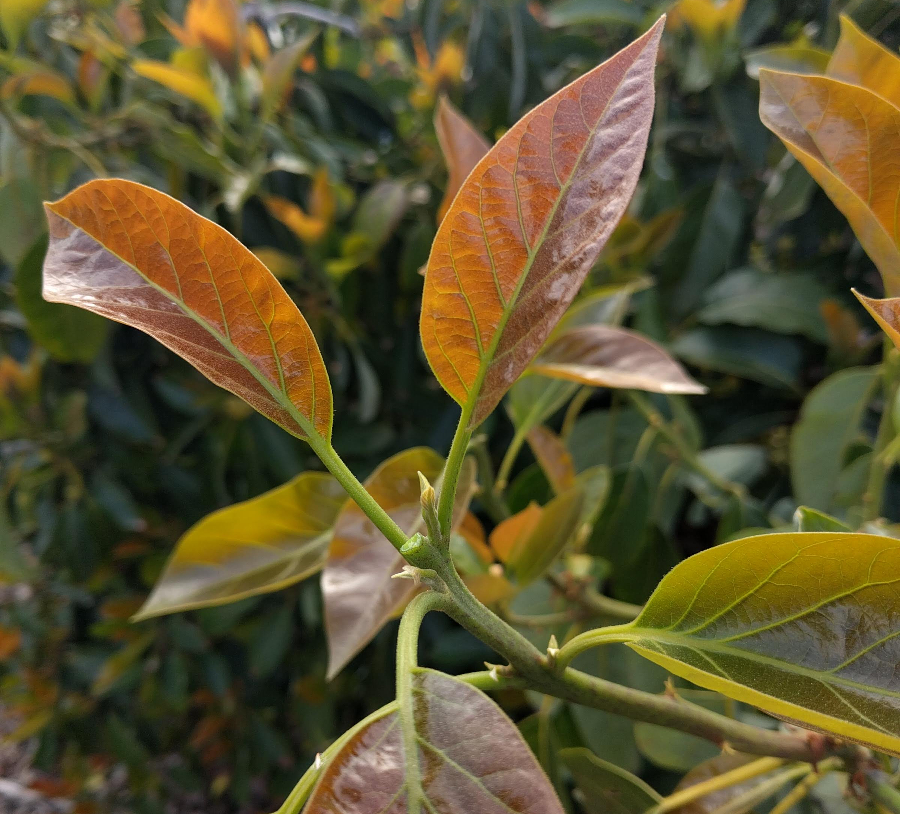
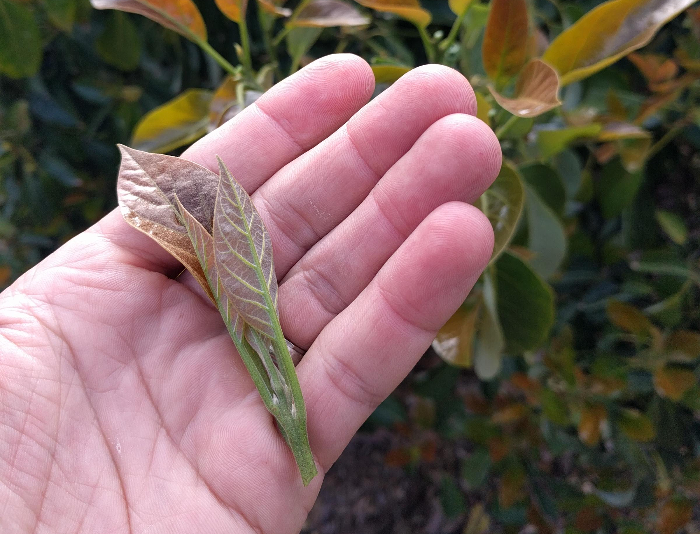
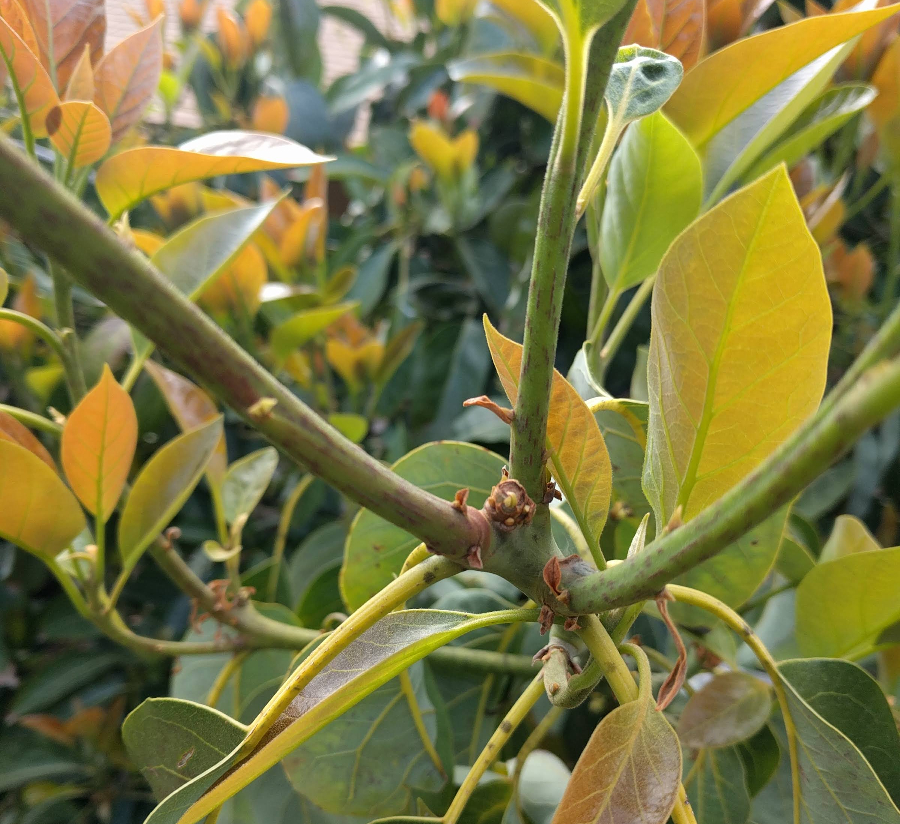
Video
In this video I show when I have and haven’t done what’s best for a few of my avocado trees in relation to pinching, pruning, sunburning, breaking branches, and removing fruit.
Sometimes you have to learn the hard way and sunburn a branch or break one or stunt a young tree before you get a sense of how much fruit can be kept or how branches need to be trained. This is how I have had to learn, mostly.
But I’ve also been lucky to be able to visit many other yards and farms, and there I’ve observed the consequences of growers who are more and less risky, or ignorant or negligent or greedy, one might say. And this has enabled me to skip over the lessons I’ve seen them learn the hard way.
All in all, I believe that if we continually put the health of our trees above our desires for maximum avocados in the short term, our trees will reward us for this generosity down the line.
Related posts:
“Growing avocados in California’s Central Valley”
“Which avocado fruitlets should you remove?”
“Not thinning enough fruit from a plum tree”
A list of all Yard Posts.
Do these articles and videos help you grow avocados? Say thanks with a show of support.

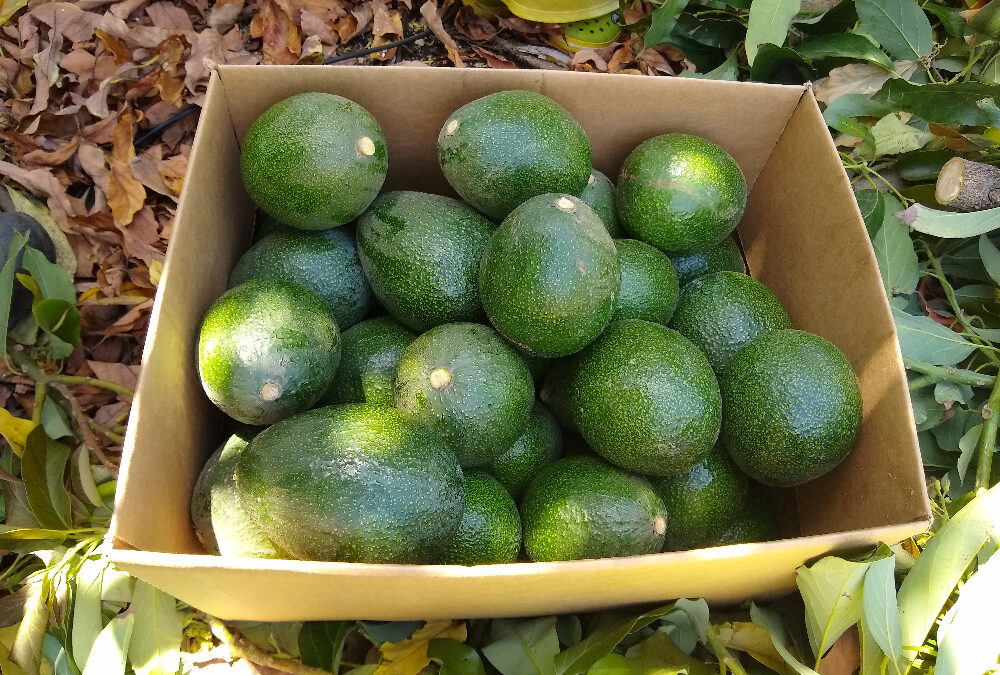


This is a very timely post as usual. I have a Reed I planted 3 years ago from a five gallon pot. It started growing rather slow the first year plus I believe due to a mistake during planting. But in 2022 it started growing well and set seven fruit even though it was maybe chest high. Those seven fruit all dropped in late May. They were pretty good, but not great. Now the tree is between 7 and 8 feet tall and has 25+ fruit on it. I’ve been wondering how many to remove, thinking I will go down to around 15 fruit. Thanks for the reminder!
Greg, one thing I enjoy about your posts is that you understand the science and include techniques that would be impracticable for a large grower, but incredible for the backyard avocado grower.
Here in Irvine I have learned that until a small tree gets its roots deep, it’s at the whim of surface conditions and maybe root rot? I have a long iron rod that I now poke deep into the clay-like silt beneath my avocado trees. Years ago I did this with a water probe (mightyprobe,com has a similar tool), deep under a Hass that thrived. My theory: Avocados want air and deep drainage into holes. I told you separately about the freaky growth that comes from spraying diluted urea on flush growth.
My point: Researchers are understandably focused on big growers. Research for backyard growers is valuable, too. Greg pays attention to both.
Thanks for bringing up these interesting ideas, Randy. Your experience with your Hass and poking the iron rod into the dirt below reminds me of this passage:
“In most plant species, the air content in the root zone needs to be more than 10% of the total soil volume, however, for avocado roots to develop well the appropriate threshold is about 30%.”
From here: http://www.avocadosource.com/CAS_Yearbooks/CAS_93_2010/CAS_2010_V93_PG_101-124.pdf
I’ve seen avocado roots growing in the hollows of abandoned gopher tunnels and throughout coarse wood-chip mulch. Both of these places have no dirt but lots of moist air, just like the holes you poked would have. I wonder if this could be a beneficial practice to do under any avocado tree growing in heavier soil?
There was another study that showed avocado roots die very quickly when completely submerged (submersed?), as in a couple of days. Avocados want to breathe. I’ve seen the same think with pine bark chunks completely infiltrated with feeder roots. Interesting to know about the gopher holes, perhaps worth inviting a temporary infestation? 🙂
Strangely enough, my goal in drilling with the water probe was deep root watering because a Hass wasn’t doing well. I was ignorant of the need for air. But the tree took off and never looked back.
Perhaps deep holes into the subsoil offer both drains for excess water, access to air, and possibly guides for deeper roots into the subsoil where temperatures and water (and air?) are more stable? Based on bitter experience, little trees on the surface are so vulnerable that a hot spell can kill them. Inevitably, the holes I made with the water probe must have silted in. Would I advise making holes under trees? The practice at a minimum satisfies the Hippocratic Oath, “First, do no harm.”
Hi Greg, Have been enjoying all the knowledge you have to share!
I’m “asking what my tree needs” based on a very large pit and thin layer of edible avocado.
This is a 7 ft. Zutano we planted with flowers on it this April. The flowers produced an abundance of fruit, many of which dropped off. Several stayed on the tree that matured. According to your calendar/chart, these should be ready around Dec to Feb. One was pulled off by a critter that decided it wasn’t worth eating. I ripened it then cut into it. I was surprised by how large the pit is.
Thoughts?
Hi Patty,
Zutano avocados always have large seeds compared to some other varieties such as Hass. Their seeds are also pointy. See some Zutano fruit in my profile video on this page: https://gregalder.com/yardposts/avocado-variety-profiles/
Do your avocados look similar?
I read that leaving fruit on an avocado tree can cause it to become alternate bearing. I think I made that mistake with my Gem, trying to harvest as needed and make them last. Do you think there is any credibility to this? If so, is it reversible? Lots of flowers, small harvest this year. Thanks
Its worth mentioning that we had a lot of fog while it was flowering so pollinator activity was likely low.
Hi Peter,
I’ve seen some weak evidence from experiments that leaving the entire crop on a tree until late in its harvest season can sometimes reduce the size of the following year’s crop. In other words, the effects of doing this are inconsistent. For example, see this study: http://www.avocadosource.com/Journals/SAAGA/SAAGA_1991/SAAGA_1991_PG_27-37.pdf
More importantly for you, I’ve never seen evidence that harvesting as you did (as needed) will have any effect on the following year’s crop. I wouldn’t consider it a factor.
Lots of people have small crops on their trees (including GEM trees) this year, and it seems mostly due to the cool, wet, foggy spring and low pollinator activity, as you mentioned. I should note that some people have large crops on their trees though, so it’s curious as to why the different results despite the same general weather throughout Southern California.
Hi Greg…interesting as usual. I thin fruit on all my trees: avo, citrus, and stone/pome… especially if a branch looks to be in trouble… and there is upcoming rain/wind. With that said, I have to be a bit cautious as Avo tree limbs seem to regularly bow, so I’m learning to decide how much is OK or not. Anyway, enjoyed the post! See ya, Robert
Will the fruit you removed because you needed to thin them ripen (the box of the removed fruit)? I was wondering if these will ripen eventually so that they are edible? I was curious because sometimes the avocados that I purchase from grocery stores are still firm, but some will have some black flesh inside when I think they have ripen enough to cut open.
Hi Laura,
I thought of that box of fruit as just compost material, but I let them ripen and finally ate one last night and it was surprisingly palatable. The skin shriveled a lot, the texture was only acceptable, and the flavor was bland, but since there are no excellent avocados available this time of year I’m probably going to eat through the entire box!
The grocery store avocados are another story. There are so many reasons that they are often of poor quality as you described. Sometimes the Hass from Mexico are harvested when immature and so they never ripen to a good texture or flavor. The black flesh inside is sometimes caused by the fruit getting banged around for weeks on its travel from tree to store shelf. There are lots of other causes too.
Hi Greg! I’m wondering if you have any experience with an avocado tree trunk cracking vertically? I have a tree that set out a strong offshoot off the side of the trunk about 6 inches off the ground. I just noticed that the base trunk has a vertical crack right below the new growth. The new growth did grow very quickly and is already very thick and tall. I’m wondering if I should chop off the new growth if it’s too heavy fit the trunk to bear, but I’m not sure if it is even the cause of the crack. The reason I am unsure is because my tree has two main trunks that split off about 2 inches off the ground. These two trunks grow straight up and are flush with each other. I’m wondering if those two trunks are pushing against each other as they grow in diameter, causing cracking in one trunk. I would love to hear your thoughts about this! Thank you! Happy holidays 🙂
For reference, the bottom of my tree (including the two trunks and the crack on the left trunk) looks something like this:
\ \ | | |
\ \ | | |
\ \ | | |
\ \| | |
\ | |
\ \ | |
| ) |
| |
——-|———-———|—
Hopefully the spacing posts well as a comment! Thanks again!
Oops that did not post well at all… hopefully you were able to get some sort of idea of what I meant 🙂
So sorry for all the comments, but I found a way to link an image of the base of my tree:
Sorry for all the comments, but I found a way to link an image of the base of my tree: https://photos.app.goo.gl/MaSxbuCYY9jj5YaK6
I would love any insight you could provide on what to do here. The left trunk is the grafted part of the tree and is producing Hass avocados while the right side of the tree is the rootstock and is not producing at all. The grafted part originally died back when I first planted the tree but somehow grew back after a year and is now taking over the tree. However, the right side has gotten pretty big as well. I wouldn’t mind cutting off the right trunk if that is what is making my tree crack, but I am worried about potentially killing the tree by making such a big chop.
Hi Charlene,
I see the photos. If the right trunk is rootstock and not Hass, then you have to chop it off or else it will take over the whole tree eventually. The Hass part will not be able to compete.
Here in early winter is a good time to do that big chop, unless you are in a location that is likely to get freeze damage, in which case I would wait until late winter (March).
Hello Greg, I have been following your posts for a while now. Thanks for all the great insight and information! I have a question about harvesting fruit before it is the “ideal” size. I am probably being greedy…
I have some relatively young avocado trees that just started to bear fruit last season. One tree is a Fuerte, about 10 feet tall and the canopy is about 8-10 feet in diameter. The Fuerte tree is about 7 years old. The Fuerte tree has about 15 avocados that are almost ready to harvest but a little on the small side. The other tree is a Hass, about 8 feet tall and the canopy is about 6-8 feet in diameter. The Hass tree is about 4 years old. The Hass has about 30 avocados that are almost ready to harvest but definitely small. I harvested one Hass from a heavy branch about 2 weeks ago and it ripened nicely indoors.
Both the Hass and the Fuerte have just finished flowering and have a good number of new tiny fruit appearing. My question is this: considering the age and size of the trees, should I harvest some (or most?) of last season’s fruit now, even though they are a bit smaller than I’d like, so that the tree can focus on the new fruit?
I am in Vista so similar climate to you.
Hi Peter,
Thank you. I would harvest the Fuertes now, as fast as you can eat them, no matter the size, because they will taste good and will deteriorate in quality starting very soon. I would then harvest the Hass as fast you want to eat them because they will be good to eat, and even the small ones should reach their peak in quality here in May or June.
It will be an incidental benefit that harvesting allows the trees to no longer support the mature fruit and instead send all energy to the new crop.
Thanks Greg. After I posted I searched more and found your posts on when to harvest, and I see the Fuerte harvest season ended in April. I will be out picking some Fuertes today!